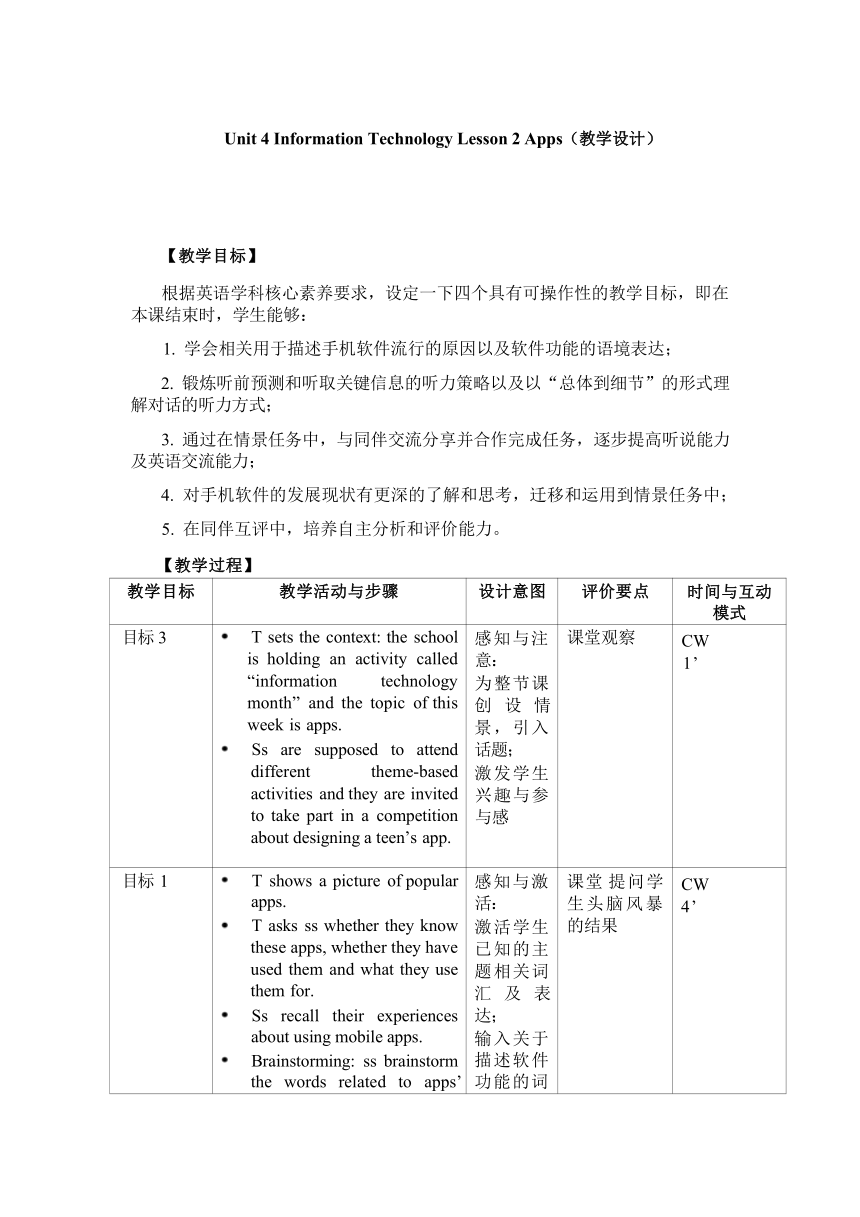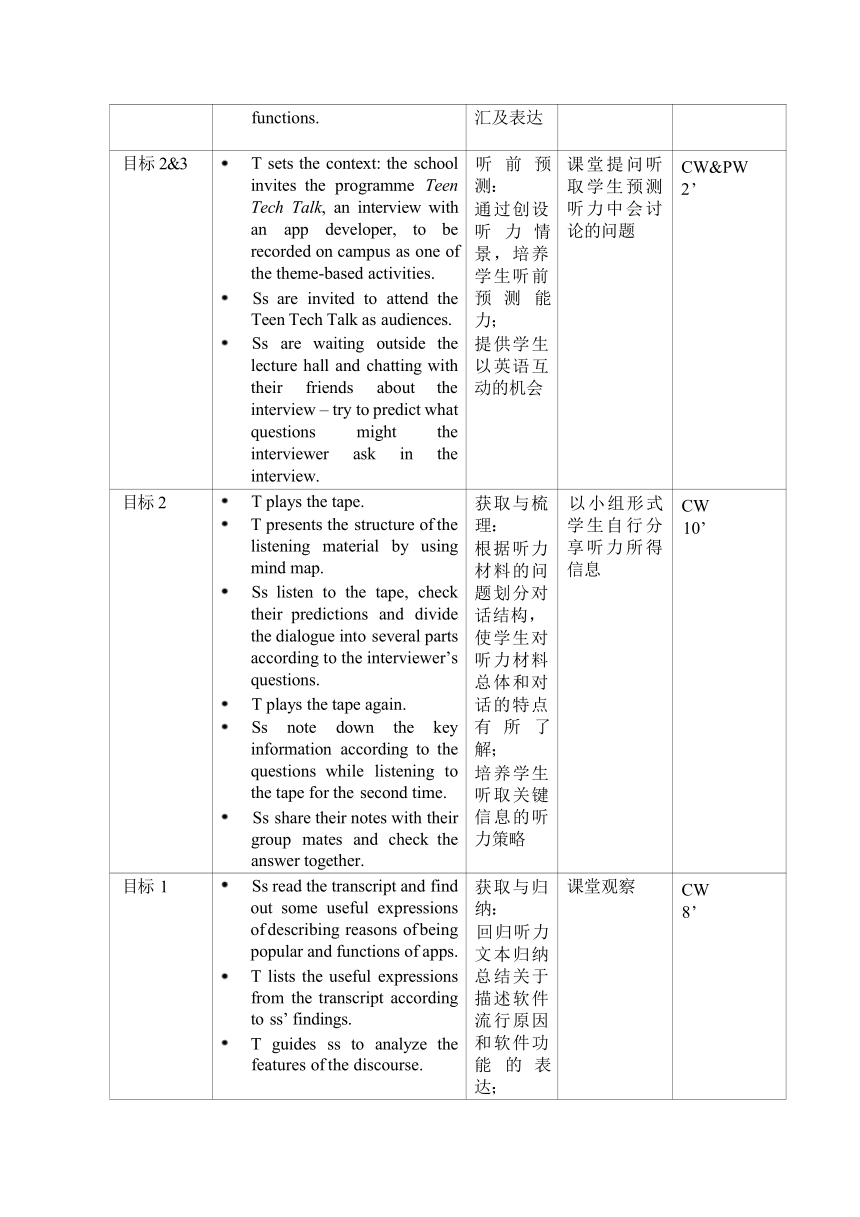北师大版(2019)必修 第二册Unit 4 INFORMATION TECHNOLOGY Lesson 2 APPS教学设计(表格式)
文档属性
| 名称 | 北师大版(2019)必修 第二册Unit 4 INFORMATION TECHNOLOGY Lesson 2 APPS教学设计(表格式) |  | |
| 格式 | docx | ||
| 文件大小 | 33.6KB | ||
| 资源类型 | 教案 | ||
| 版本资源 | 北师大版(2019) | ||
| 科目 | 英语 | ||
| 更新时间 | 2025-01-11 14:52:00 | ||
图片预览


文档简介
Unit 4 Information Technology Lesson 2 Apps(教学设计)
【教学目标】
根据英语学科核心素养要求,设定一下四个具有可操作性的教学目标,即在 本课结束时,学生能够:
1. 学会相关用于描述手机软件流行的原因以及软件功能的语境表达;
2. 锻炼听前预测和听取关键信息的听力策略以及以“总体到细节”的形式理 解对话的听力方式;
3. 通过在情景任务中,与同伴交流分享并合作完成任务,逐步提高听说能力 及英语交流能力;
4. 对手机软件的发展现状有更深的了解和思考,迁移和运用到情景任务中;
5. 在同伴互评中,培养自主分析和评价能力。
【教学过程】
教学目标 教学活动与步骤 设计意图 评价要点 时间与互动 模式
目标 3 T sets the context: the school is holding an activity called “information technology month” and the topic of this week is apps. Ss are supposed to attend different theme-based activities and they are invited to take part in a competition about designing a teen’s app. 感知与注 意: 为整节课 创 设 情 景,引入 话题; 激发学生 兴趣与参 与感 课堂观察 CW 1 ’
目标 1 T shows a picture of popular apps. T asks ss whether they know these apps, whether they have used them and what they use them for. Ss recall their experiences about using mobile apps. Brainstorming: ss brainstorm the words related to apps’ 感知与激 活: 激活学生 已知的主 题相关词 汇 及 表 达; 输入关于 描述软件 功能的词 课堂 提问学 生头脑风暴 的结果 CW 4’
functions. 汇及表达
目标 2&3 T sets the context: the school invites the programme Teen Tech Talk, an interview with an app developer, to be recorded on campus as one of the theme-based activities. Ss are invited to attend the Teen Tech Talk as audiences. Ss are waiting outside the lecture hall and chatting with their friends about the interview – try to predict what questions might the interviewer ask in the interview. 听 前 预 测: 通过创设 听 力 情 景,培养 学生听前 预 测 能 力; 提供学生 以英语互 动的机会 课堂提问听 取学生预测 听力中会讨 论的问题 CW&PW 2’
目标 2 T plays the tape. T presents the structure of the listening material by using mind map. Ss listen to the tape, check their predictions and divide the dialogue into several parts according to the interviewer’s questions. T plays the tape again. Ss note down the key information according to the questions while listening to the tape for the second time. Ss share their notes with their group mates and check the answer together. 获取与梳 理: 根据听力 材料的问 题划分对 话结构, 使学生对 听力材料 总体和对 话的特点 有 所 了 解; 培养学生 听取关键 信息的听 力策略 以小组形式 学生自行分 享听力所得 信息 CW 10’
目标 1 Ss read the transcript and find out some useful expressions of describing reasons of being popular and functions of apps. T lists the useful expressions from the transcript according to ss’ findings. T guides ss to analyze the features of the discourse. 获取与归 纳: 回归听力 文本归纳 总结关于 描述软件 流行原因 和软件功 能 的 表 达; 课堂观察 CW 8’
从文本语 篇特点归 纳出如何 描述一款 软件
目标 3&4 T sets the context: the highlight of the “information technology month” is the app- designing competition. T gives an example. Group work roles S1: leader & presenter S2: idea organizer S3: language supervisor S4: poster drawer S5: note taking & time keeper Each group is supposed to design an educational app based on one of the 4 given situations and design a poster to promote the app, including the app’s name, target users and functions. Two groups share a given situation. Group members work out their app together and finish the poster in 5 minutes. 迁移与创 新: 在情景化 任务中, 学生迁移 与运用课 中所学的 语 言 表 达; 鼓励学生 进行创新 性思考; 为小组学 生设定角 色,最大 化每位学 生的参与 度; 鼓励学生 在合作性 学习中, 共同解决 问题 观察与指导 小组合作过 程及海报完 成进度 GW 7’
目标 3 、4、 “Gallery Presentation” 输 出 展 检验海报完 GW&CW
5 1s (presenter) from each 示: 成程度; 8 ’
group is supposed to present 通过“画 学生互评;
their work to another group one by one as a circle, which means all the groups are presenting at the same time. The rest of the group members should stay in their own group listening to other groups’ presentation. 廊 式 展 示”,最大 化学生课 堂 输 出 (口语展 示)时间 和 参 与 度; 学生展示,教 师给予开放 性的评价
The rest of the group members should evaluate other groups’ works according to the given standard after listening. Each 通过同伴 互评,鼓 励学生思 考同伴的 输 出 成
student (except presenters) has 4 star-stickers which can be given to the apps (4 different apps from other groups) better meet the situations’ needs. T makes comments on the “most popular” app and summarizes the lesson. 果,培养 自主分析 和评价能 力
Homework: ss are going to promote their apps to the whole school. Turn the poster into a short passage and submit it to the school’s magazine.
附件 1
Information Cards
Group 1&2: Alice is going to pay a visit to Britain with her parents (in their 40s) who don’t know any English. She wants to recommend an app for her parents to learn
some daily-used oral English.
Group 3&4: Mike (9 years old) has difficulties in memorizing the spelling of English words. Gradually, he lost confidence in learning English.
Group 5&6: Grace (15 years old) went to America last summer vacation and found people there could hardly understand her pronunciation. She feels worried and wants to improve her speaking.
Group 7&8: Alan (16 years old) finds understanding English grammar difficult, which results in his weaknesses of reading and writing. He is in great need of improving his grammar.
附件 2
Evaluation Prompts for Presentation
Evaluation Prompts Perfect Good but to be perfected Sorry, not at all
Does the app meet the target user’s need 2 1 0
Is the design (app and poster) creative 2 1 0
Is the content well-organized 2 1 0
Does the group use the expressions learnt this class correctly and properly 2 1 0
Does the presenter speak English loudly and fluently 2 1 0
【教学目标】
根据英语学科核心素养要求,设定一下四个具有可操作性的教学目标,即在 本课结束时,学生能够:
1. 学会相关用于描述手机软件流行的原因以及软件功能的语境表达;
2. 锻炼听前预测和听取关键信息的听力策略以及以“总体到细节”的形式理 解对话的听力方式;
3. 通过在情景任务中,与同伴交流分享并合作完成任务,逐步提高听说能力 及英语交流能力;
4. 对手机软件的发展现状有更深的了解和思考,迁移和运用到情景任务中;
5. 在同伴互评中,培养自主分析和评价能力。
【教学过程】
教学目标 教学活动与步骤 设计意图 评价要点 时间与互动 模式
目标 3 T sets the context: the school is holding an activity called “information technology month” and the topic of this week is apps. Ss are supposed to attend different theme-based activities and they are invited to take part in a competition about designing a teen’s app. 感知与注 意: 为整节课 创 设 情 景,引入 话题; 激发学生 兴趣与参 与感 课堂观察 CW 1 ’
目标 1 T shows a picture of popular apps. T asks ss whether they know these apps, whether they have used them and what they use them for. Ss recall their experiences about using mobile apps. Brainstorming: ss brainstorm the words related to apps’ 感知与激 活: 激活学生 已知的主 题相关词 汇 及 表 达; 输入关于 描述软件 功能的词 课堂 提问学 生头脑风暴 的结果 CW 4’
functions. 汇及表达
目标 2&3 T sets the context: the school invites the programme Teen Tech Talk, an interview with an app developer, to be recorded on campus as one of the theme-based activities. Ss are invited to attend the Teen Tech Talk as audiences. Ss are waiting outside the lecture hall and chatting with their friends about the interview – try to predict what questions might the interviewer ask in the interview. 听 前 预 测: 通过创设 听 力 情 景,培养 学生听前 预 测 能 力; 提供学生 以英语互 动的机会 课堂提问听 取学生预测 听力中会讨 论的问题 CW&PW 2’
目标 2 T plays the tape. T presents the structure of the listening material by using mind map. Ss listen to the tape, check their predictions and divide the dialogue into several parts according to the interviewer’s questions. T plays the tape again. Ss note down the key information according to the questions while listening to the tape for the second time. Ss share their notes with their group mates and check the answer together. 获取与梳 理: 根据听力 材料的问 题划分对 话结构, 使学生对 听力材料 总体和对 话的特点 有 所 了 解; 培养学生 听取关键 信息的听 力策略 以小组形式 学生自行分 享听力所得 信息 CW 10’
目标 1 Ss read the transcript and find out some useful expressions of describing reasons of being popular and functions of apps. T lists the useful expressions from the transcript according to ss’ findings. T guides ss to analyze the features of the discourse. 获取与归 纳: 回归听力 文本归纳 总结关于 描述软件 流行原因 和软件功 能 的 表 达; 课堂观察 CW 8’
从文本语 篇特点归 纳出如何 描述一款 软件
目标 3&4 T sets the context: the highlight of the “information technology month” is the app- designing competition. T gives an example. Group work roles S1: leader & presenter S2: idea organizer S3: language supervisor S4: poster drawer S5: note taking & time keeper Each group is supposed to design an educational app based on one of the 4 given situations and design a poster to promote the app, including the app’s name, target users and functions. Two groups share a given situation. Group members work out their app together and finish the poster in 5 minutes. 迁移与创 新: 在情景化 任务中, 学生迁移 与运用课 中所学的 语 言 表 达; 鼓励学生 进行创新 性思考; 为小组学 生设定角 色,最大 化每位学 生的参与 度; 鼓励学生 在合作性 学习中, 共同解决 问题 观察与指导 小组合作过 程及海报完 成进度 GW 7’
目标 3 、4、 “Gallery Presentation” 输 出 展 检验海报完 GW&CW
5 1s (presenter) from each 示: 成程度; 8 ’
group is supposed to present 通过“画 学生互评;
their work to another group one by one as a circle, which means all the groups are presenting at the same time. The rest of the group members should stay in their own group listening to other groups’ presentation. 廊 式 展 示”,最大 化学生课 堂 输 出 (口语展 示)时间 和 参 与 度; 学生展示,教 师给予开放 性的评价
The rest of the group members should evaluate other groups’ works according to the given standard after listening. Each 通过同伴 互评,鼓 励学生思 考同伴的 输 出 成
student (except presenters) has 4 star-stickers which can be given to the apps (4 different apps from other groups) better meet the situations’ needs. T makes comments on the “most popular” app and summarizes the lesson. 果,培养 自主分析 和评价能 力
Homework: ss are going to promote their apps to the whole school. Turn the poster into a short passage and submit it to the school’s magazine.
附件 1
Information Cards
Group 1&2: Alice is going to pay a visit to Britain with her parents (in their 40s) who don’t know any English. She wants to recommend an app for her parents to learn
some daily-used oral English.
Group 3&4: Mike (9 years old) has difficulties in memorizing the spelling of English words. Gradually, he lost confidence in learning English.
Group 5&6: Grace (15 years old) went to America last summer vacation and found people there could hardly understand her pronunciation. She feels worried and wants to improve her speaking.
Group 7&8: Alan (16 years old) finds understanding English grammar difficult, which results in his weaknesses of reading and writing. He is in great need of improving his grammar.
附件 2
Evaluation Prompts for Presentation
Evaluation Prompts Perfect Good but to be perfected Sorry, not at all
Does the app meet the target user’s need 2 1 0
Is the design (app and poster) creative 2 1 0
Is the content well-organized 2 1 0
Does the group use the expressions learnt this class correctly and properly 2 1 0
Does the presenter speak English loudly and fluently 2 1 0
同课章节目录
- Unit 4 Information technology
- Lesson 1 Avatars
- Lesson 2 Apps
- Lesson 3 Internet and Friendships
- Unit 5 Humans and nature
- Lesson 1 A Sea Story
- Lesson 2 Professional Rescue Team
- Lesson 3 Race to the Pole
- Unit 6 The admirable
- Lesson 1 A Medical Pioneer
- Lesson 2 History Makers
- Lesson 3 The Superhero Behind Superman
